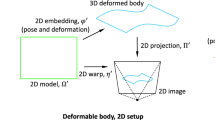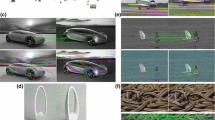Abstract
Given multiple image data from a set of points in 3D, there are two fundamental questions that can be addressed:
What is the structure of the set of points in 3D?
What are the positions of the cameras relative to the points?
In this paper we show that, for projective views and with structure and position defined projectively, these problems are dual because they can be solved using constraint equations where space points and camera positions occur in a reciprocal way. More specifically, by using canonical projective reference frames for all points in space and images, the imaging of point sets in space by multiple cameras can be captured by constraint relations involving three different kinds of parameters only, coordinates of: (1) space points, (2) camera positions (3) image points. The duality implies that the problem of computing camera positions from p points in q views can be solved with the same algorithm as the problem of directly reconstructing q + 4 points in p - 4 views. This unifies different approaches to projective reconstruction: methods based on external calibration and direct methods exploiting constraints that exist between shape and image invariants.
Similar content being viewed by others
References
Carlsson, S. 1994. The double algebra: An effective tool for computing invariants in computer vision. Applications of Invariance in Computer Vision, Springer, LNCS 825, pp. 145-164.
Carlsson, S. 1995a. View variation and linear invariants in 2-D and 3-D. Tech. rep., Royal Institute of Technology, ISRN KTH/NA/ P-95/22-SE.
Carlsson, S. 1995b. Duality of reconstruction and positioning from projective views. In IEEE Workshop on Representations of Visual Scenes, Cambridge, MA.
Chen, H.H. and Huang, T.S. 1990. Matching 3-D line segments with applications to multiple-object motion estimation. T-PAMI 12, pp. 1002-1008.
Csurka, G. and Faugeras, O.D. 1994. Computing three-dimensional projective invariants from a pair of images using the Grassmann-Cayley algebra. Tech. report, INRIA-Sophia Antipolis.
Demey, S., Ziserman, A., and Beardley, P. 1992. Affine and projective structure from motion. In Proc. BMVC-92.
Faugeras, O.D. 1992. What can be seen in three dimensions with an uncalibrated stereo rig? In Proc. 2nd ECCV, pp. 563- 578.
Faugeras, O.D., Luong, Q.T., and Maybank, S.J. 1992. Camera selfcalibration: Theory and experiments. In Proc. 2ndECCV, pp. 321-334.
Faugeras, O.D. and Mourrain, B. 1995. Algebraic and geometric properties of point correspondences between N images. In Proc 5th ICCV, pp. 951-956.
Gros, P. 1994. How to use the cross ratio to compute invariants from two images. Applications of Invariance in Computer Vision, Springer, LNCS 825, pp. 107-126.
Hartley, R.I. 1994. Lines and Points in Three Views-An Integrated Approach IUWS.
Hartley, R., Gupta, R., and Chang, T. 1992. Stereo from uncalibrated cameras. In Proc. CVPR, pp. 761-764.
Heyden, A. 1995a. Reconstruction from image sequences by means of relative depths. In Proc 5th ICCV, pp. 1058-1063.
Heyden, A. 1995b. Reconstruction from multiple images using kinetic depths. Tech. Report. Dep. of Mathematics, Lund University.
Irani, M. and Anandan, P. 1996. Parallax geometry of pairs of points for 3D scence analysis. In Proc. 4th ECCV, vol. I, pp. 17- 30.
Koenderink, J.J. and van Doorn, A.J. 1991. Affine structure from motion, J. Optic. Soc. Am. A, 2:377-385.
Long Quan. 1994. Invariants of 6 points from 3 uncalibrated images. In Proc. 3rd ECCV, vol. 2, pp. 459-470.
Longuet-Higgins, H.C. and Prazdny, K. 1980. The interpretation of a moving retinal image. In Proc. Roy. Soc. Lond. B-208, pp. 385- 397.
Luong, Q.-T. and Viéville, T. 1994. Canonic representations for the geometries of multiple projective views. In Proc. 3rd ECCV.
Maybank, S.J. 1990. The projective geometry of ambiguous surfaces. In Proc. Royal Soc. A, vol. 322, pp. 1-47.
Mohr, R. 1992. Projective geometry and computer vision. Handbook of Pattern Recognition and Computer Vision.
Mohr, R., Quan, L., and Veillon, F. 1995. Relative 3-D reconstruction using multiple uncalibrated images international. Journal of Robotics Research, 6:619-632.
Rothwell, C.A., Forsyth, D.A., Zisserman, A.P., and Mundy, J.L. 1993. Extracting projective structure from single perspective views of 3-D point sets. In Proc. of 4th ICCV, pp. 573-582.
Shashua, A. 1993. Projective depth: A geometric invariant for 3D reconstruction from two perspective/orthographic views and for visual recognition. In Proc 4th ICCV, pp. 583-590.
Shashua, A. 1994. Trilinearity in visual recognition by alignment. In Proc. 3rd ECCV A, pp. 479-484.
Shashua, A. 1995. Algebraic functions for recognition. IEEE Transactions on Pattern Analysis and Machine Intelligence, 17(8):779- 789.
Shashua, A. and Werman, M. 1995. Trilinearity of three perspective views and its associated tensor. In Proc 5th ICCV, pp. 920-925.
Shashua, A. and Avidan, S. 1996. The rank4 constraint in multiple view geometry. In Proc. 4th ECCV, pp. 196-206.
Sparr, G. 1991. In Proc. 1st ESPRIT-DARPAWorkshop on Invariants in Computer Vision, Reykjavik.
Sparr, G. 1992. Depth Computations from polyhedral images. Image and Vision Computing, 10(10):683-688.
Sparr, G. 1994. A common framework for kinetic depth, reconstruction and motion for deformable objects. In Proc.ECCVB, pp. 471- 482.
Spetsakis, M.E. and Aloimonos, J.(Y.). 1990. Structure from motion using line correspondences. International Journal of Computer Vision, 4:171-183.
Tomasi, C. and Kanade, T. 1992. Shape and motion from image streams under orthography: Afactorization method. International Journal of Computer Vision, 9(2):137-154.
Triggs, B. 1995. Matching constraints and the joint image. In Proc 5th ICCV, pp. 338-343.
Weinshall, D. 1993. Model-based invariants for 3D vision. International Journal of Computer Vision, 10(1):27-42.
Weinshall, D. and Tomasi, C. 1995. Linear and incremental acquisition of invariant shape models from image sequences. IEEE Transactions on Pattern Analysis and Machine Intelligence, 17(5):512-517.
Weinshall, D., Werman, M., and Shashua, A. 1995. Shape tensors for efficient and learnable indexing. In Proc. of the IEEE Workshop on Representations of Visual Scenes, Cambridge, MA.
Zisserman, A. 1994. A case against epipolar geometry. Applications of Invariance in Computer Vision, Springer, LNCS 825, pp. 69-88.
Author information
Authors and Affiliations
Rights and permissions
About this article
Cite this article
Carlsson, S., Weinshall, D. Dual Computation of Projective Shape and Camera Positions from Multiple Images. International Journal of Computer Vision 27, 227–241 (1998). https://doi.org/10.1023/A:1007961913417
Issue Date:
DOI: https://doi.org/10.1023/A:1007961913417




